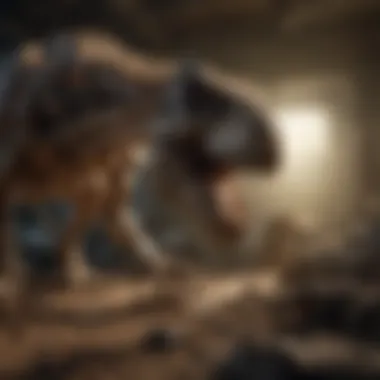Unveiling the Mysteries of Fossil Eras: A Complete Exploration


Rock and Fossil Identification
As we delve into the captivating world of fossil eras, understanding the types of rocks and fossils plays a crucial role in unraveling the mysteries of the Earth's history. Fossil identification requires a keen eye for detail and an understanding of the unique characteristics that distinguish each specimen. Rocks can vary from sedimentary to igneous and metamorphic, each providing valuable insights into past environments. Fossils, on the other hand, can range from imprints and molds to petrified remains of ancient organisms. Utilizing specialized tools such as magnifying glasses, rock hammers, and chisels can aid in the process of identification.
Collecting Tips and Techniques
To embark on a successful fossil collection journey, it is essential to follow best practices and employ effective techniques. Identifying prime collecting sites involves researching geological maps, understanding local formations, and networking with fellow collectors. When extracting specimens, care must be taken to ensure their integrity and safety. Proper tools like brushes, dental picks, and screens help in delicate extraction without damaging the fossils. Safety measures, such as wearing protective gear and obtaining necessary permissions, are paramount for a responsible collecting experience.
Preservation and Display
Preserving rocks and fossils is an art that requires knowledge of appropriate techniques and methods to maintain their integrity. Methods such as consolidation, drying, and chemical treatments help protect specimens from degradation over time. Proper storage in acid-free containers and controlled environments safeguards these treasures for future generations. Creativity comes into play when it comes to displaying rocks and fossils. From shadow boxes to custom-made stands, showcasing these pieces can enhance their aesthetic appeal and educational value.
Geological Insights
Geological formations hold the key to understanding the Earth's past and the evolution of life. Rocks and fossils provide insights into ancient environments, climate conditions, and evolutionary processes. Studying historical significance and notable discoveries enrich our knowledge of the planet's geological timeline. From the Burgess Shale to the La Brea Tar Pits, these sites have yielded invaluable fossils that have reshaped our understanding of prehistoric life.
Introduction to Fossil Eras
In the captivating realm of fossil eras, understanding the evolution of life on our planet is integral. This section serves as the gateway to a journey through the annals of time, where each era unveils a unique chapter in Earth's history. From the enigmatic Precambrian era to the dynamic Cenozoic era, the significance of comprehending these fossilized remnants cannot be overstated. By exploring fossils from different eras, we gain profound insights into the evolutionary processes that have shaped the biodiversity we observe today.
Understanding Geological Time
The Concept of Deep Time
Delving into the concept of deep time allows us to grasp the incomprehensible expanses of Earth's history that span millions to billions of years. This perspective transcends our human timescales, offering a profound realization of the vast epochs that have molded our planet. Deep time, with its immensity and scope, provides a crucial framework for interpreting geological events and evolutionary transitions. It enables us to appreciate the gradual changes that have occurred over eons, shedding light on the gradual transformations that have shaped life on Earth.
Geological Timescales
Geological timescales serve as the temporal map that organizes Earth's history into manageable units. These divisions allow us to categorize geological events, species evolution, and environmental changes into coherent timelines. By utilizing geological timescales, researchers can establish chronological frameworks for studying the fossil record and reconstructing past ecosystems. This systematic approach aids in contextualizing the diversity of life found in different eras, providing a scaffold for understanding the intricate interplay between geological processes and biological evolution.
Significance of Fossil Records
Role in Evolutionary Studies
Fossil records serve as tangible evidence of the evolutionary changes that have occurred throughout Earth's history. They offer snapshots of ancient life forms, enabling scientists to trace the evolutionary pathways of different species. By analyzing fossil remains, researchers can uncover ancestral relationships, evolutionary adaptations, and species diversity over time. Fossil records play a pivotal role in shaping our understanding of the mechanisms driving biological evolution, allowing us to decipher the intricacies of life's development on our planet.
Insights into Ancient Environments
Exploring fossilized remains provides invaluable insights into the ancient environments that once existed on Earth. Fossils preserve traces of past ecosystems, climates, and geological conditions, offering a glimpse into the habitats that sustained diverse forms of life. By studying these ancient environments, scientists can reconstruct past landscapes, ecological interactions, and climate dynamics. Fossil records act as windows into the past, allowing us to piece together the puzzle of Earth's environmental history and the factors that have influenced biological evolution.
Precambrian Era


The Precambrian Era is a pivotal period in the Earth's geological history, essential to understanding the evolution of life on our planet. In this article, we delve deeply into the complexities and significance of the Precambrian Era, uncovering its unique characteristics and the valuable insights it offers. By focusing on the Precambrian Era, we gain a profound understanding of the foundational processes that set the stage for the emergence of life as we know it today.
Hadean Period
Formation of Earth
The Formation of Earth is a fundamental aspect of the Hadean Period, marking the earliest stages of our planet's development. This stage holds immense importance in our exploration as it lays the groundwork for the intricate geological processes that shaped Earth's surface. The Formation of Earth signifies the birth of our planet and sets the context for the subsequent evolution of life forms. This section provides a detailed analysis of the specific mechanisms involved in the Formation of Earth, highlighting its significance in the broader scope of understanding Earth's history.
Extreme Conditions
The Extreme Conditions characteristic of the Hadean Period present a fascinating narrative of the challenges Earth faced during its formative years. These extreme environments, marked by intense heat and volcanic activity, reveal the harsh conditions early life forms had to endure. By examining the Extreme Conditions of the Hadean Period, we gain a profound appreciation for the resilience and adaptability of life in the face of adversity. This section sheds light on the unique features of these extreme environments and explores their contributions to shaping the early Earth.
Archean Period
Early Life Forms
The Archean Period signifies a crucial juncture in the history of life on Earth, showcasing the emergence of Early Life Forms. This section of our exploration delves into the fascinating diversity of primitive life forms that thrived during this period. By examining the Early Life Forms of the Archean Period, we gain valuable insights into the origin and diversification of life on our planet. This segment highlights the unique characteristics of these early organisms and their contributions to the evolution of life.
Emergence of Photosynthesis
The Emergence of Photosynthesis revolutionized the Earth's ecosystems during the Archean Period, paving the way for significant biological transformations. This pivotal development enabled ancient organisms to harness light energy, leading to the oxygenation of the atmosphere. Exploring the Emergence of Photosynthesis provides a glimpse into the adaptation strategies that shaped early life forms and influenced the Earth's biogeochemical cycles. By delving into this landmark event, we unravel the intricate relationship between photosynthetic organisms and the evolving Earth environment.
Proterozoic Eon
Diversification of Life
The Proterozoic Eon marks a period of intense Diversification of Life, showcasing the proliferation of various life forms across different environments. This era witnessed a remarkable expansion in biological diversity, leading to the emergence of complex organisms and ecosystems. By exploring the Diversification of Life during the Proterozoic Eon, we uncover the intricate relationships between species and their environments. This section delves into the key factors driving biological evolution and the adaptations that shaped the course of life on Earth.
Climatic Changes
The Proterozoic Eon was characterized by significant Climatic Changes that influenced the course of evolution and ecosystem dynamics. These fluctuations in climate patterns had profound implications for the distribution and survival of life forms during this period. By examining the Climatic Changes of the Proterozoic Eon, we gain a deeper understanding of the intricate balance between environmental factors and biological adaptations. This segment explores the diverse responses of organisms to changing climatic conditions and their long-term impacts on Earth's ecosystems.
Paleozoic Era
In the vast geological timeline of Earth, the Paleozoic Era stands as a crucial chapter that witnessed significant evolutionary events shaping the planet's biodiversity. This era, spanning from around 541 million years ago to 252 million years ago, is renowned for the emergence of complex life forms and the diversification of organisms. Understanding the Paleozoic Era is fundamental in unraveling the historical tapestry of life on Earth, providing key insights into the origins of various species and ecosystems.
Cambrian Period
Explosion of Life
The Cambrian Period marks a pivotal moment in Earth's history characterized by the rapid proliferation of diverse marine life forms. The 'Explosion of Life' phenomenon during this period saw the emergence of complex multicellular organisms, marking a significant evolutionary leap. This burst of biodiversity laid the foundation for future ecosystems, setting the stage for the diverse biomes that followed. The unique aspect of the Explosion of Life lies in its sudden and widespread impact on the marine environment, transforming it into a bustling hub of evolving life forms.


Burgess Shale Fauna
The Burgess Shale Fauna represents a remarkable fossil deposit dating back to the Cambrian Period, renowned for its exceptional preservation of ancient marine life forms. This fossil assemblage offers invaluable insights into the biodiversity and ecological dynamics of early marine ecosystems. The key characteristic of the Burgess Shale Fauna lies in its detailed preservation of soft-bodied organisms, providing a rare glimpse into ancient marine faunas. Studying this unique fossil bed enables researchers to reconstruct past marine communities, shedding light on the intricate relationships between early organisms.
Ordovician Period
Diversification of Marine Life
During the Ordovician Period, Earth experienced a significant expansion in marine biodiversity marked by the proliferation of various marine life forms. The 'Diversification of Marine Life' phenomenon denotes the explosive growth and diversification of marine species, leading to the establishment of complex marine ecosystems. This diversification laid the foundation for future marine faunas, shaping the interactions between species and the evolution of marine communities.
Mass Extinction Events
The Ordovician Period was punctuated by several mass extinction events that reshaped marine ecosystems and influenced the course of evolution. These catastrophic events, though devastating in their consequences, played a crucial role in resetting ecological balances and driving evolutionary novelties. The key characteristic of Mass Extinction Events lies in their role as transformative forces, triggering shifts in species compositions and ecological dynamics. Despite the challenges they posed, these events ultimately paved the way for ecological restructuring and the emergence of new adaptive strategies.
Silurian Period
First Plants on Land
The Silurian Period marks a significant milestone in Earth's history with the colonization of land by early plant life forms. The 'First Plants on Land' heralded a pivotal transition from aquatic to terrestrial environments, initiating the greening of Earth's landscapes. This botanical expansion revolutionized ecosystems, fostering new habitats and paving the way for the evolution of land-dwelling organisms. The unique feature of First Plants on Land lies in their adaptation to terrestrial life, showcasing the resilience and innovation of early plant species.
Climate Changes
The Silurian Period was also characterized by significant climatic fluctuations that influenced global environments and shaped evolutionary trajectories. Climate Changes during this period played a crucial role in shaping habitats, driving speciation events, and sculpting the distribution of species. The key characteristic of Climate Changes lies in their impact on biodiversity and ecosystem dynamics, highlighting the intricate interplay between environmental variables and evolutionary processes. Despite posing challenges to organisms, these climate fluctuations catalyzed evolutionary adaptations and resilience mechanisms.
Mesozoic Era
The Mesozoic Era holds a pivotal role in the narrative of Earth's history, making it a fundamental focus of this comprehensive guide to fossil eras. Spanning from approximately 252 to 66 million years ago, the Mesozoic Era is commonly referred to as the 'Age of Reptiles'. This era witnessed significant evolutionary developments, including the dominance of reptiles, the breakup of the supercontinent Pangaea, and the rise of iconic species like dinosaurs and early mammals. By exploring the Mesozoic Era, we gain profound insights into the dynamics of ancient ecosystems and the transformative forces that shaped life on our planet.
Triassic Period
Age of Reptiles
The 'Age of Reptiles' during the Triassic Period signifies a crucial phase where reptiles began to proliferate and diversify across varying habitats. This period marked a shift towards terrestrial dominance by reptiles, indicating a significant evolutionary milestone in the history of vertebrates. The dominance of reptiles in the Triassic Period laid the foundation for the subsequent evolutionary trajectories of different reptilian lineages, setting the stage for the grandeur of the Mesozoic Era as a whole. The unique feature of the Age of Reptiles lies in the emergence of archosaurian reptiles, a group that includes ancestors of dinosaurs and crocodiles, shaping future ecosystems and evolutionary paths.
Pangea Splitting
The phenomenon of Pangea splitting holds profound implications for the geological and biological landscapes of the Mesozoic Era. The fragmentation of the supercontinent Pangaea during the Triassic Period triggered significant shifts in climate, ocean currents, and biodiversity across separated landmasses. This separation paved the way for divergent evolutionary pathways among flora and fauna, leading to the emergence of distinct ecosystems and species. The unique feature of Pangea splitting lies in its role as a catalyst for evolutionary innovation and biogeographic isolation, driving the development of diverse ecosystems and species adaptations throughout the Mesozoic Era.
Jurassic Period
Dominance of Dinosaurs


The Jurassic Period epitomized the dominance of dinosaurs, showcasing the peak of their evolutionary success and ecological impact. Dinosaurs reigned as the ruling terrestrial vertebrates, exhibiting a remarkable diversity of forms, sizes, and behaviors. Their dominance shaped ecosystems, influencing the evolution of both flora and fauna during this iconic era. The key characteristic of the Dominance of Dinosaurs lies in their evolutionary innovations, ranging from specialized feeding adaptations to sophisticated social structures, underscoring their resilience and adaptability as a dominant faunal group.
Rise of Mammals
Contrary to the dominating presence of dinosaurs, the Jurassic Period also witnessed the gradual rise of mammals, marking a significant transition in vertebrate evolution. Mammals diversified under the shadow of dinosaurs, exploring various ecological niches and developing unique physiological features. The Rise of Mammals during the Jurassic Period represented a pivotal stage in mammalian evolution, setting the stage for their eventual ecological significance in the Cenozoic Era. The key characteristic of this rise lies in the adaptive advantages and resilience displayed by early mammals, showcasing their potential for evolutionary success amidst dinosaur-dominated environments.
Cretaceous Period
End of Dinosaurs
The Cretaceous Period culminated in a momentous event – the end of the reign of dinosaurs following a catastrophic mass extinction event. This event, known as the Cretaceous-Paleogene extinction, led to the demise of non-avian dinosaurs, clearing the stage for the subsequent evolutionary trajectories of other organisms. The key characteristic of the End of Dinosaurs lies in its profound impact on terrestrial and marine ecosystems, creating opportunities for the rapid diversification of surviving species and facilitating the rise of new ecological dominants.
Flowering Plants
The emergence and diversification of flowering plants during the Cretaceous Period heralded a botanical revolution, transforming terrestrial landscapes worldwide. The rise of angiosperms, or flowering plants, introduced new modes of reproduction, diversified plant-insect interactions, and reshaped ecosystems through the establishment of diverse plant communities. The key characteristic of Flowering Plants lies in their ecological adaptability, reproductive strategies, and co-evolutionary relationships with pollinators, establishing them as fundamental components of modern ecosystems and influencing the evolutionary trajectories of numerous plant and animal lineages.
Cenozoic Era
The Cenozoic Era, also known as the Age of Mammals, is a pivotal period in the history of life on Earth. This section of the article delves into the importance of the Cenozoic Era within the context of exploring fossil eras. As the most recent geological era, the Cenozoic Era provides crucial insights into the evolution of a vast array of life forms, particularly mammals and primates. The Cenozoic Era marks a significant transition, with the decline of dinosaurs and the rise of mammals defining this era's uniqueness. By examining fossils from this era, scientists have been able to unravel the intricacies of mammalian evolution and understand the impact of environmental changes on the development of various species.
Paleogene Period
Adaptive Radiations
Exploring the Adaptive Radiations within the Paleogene Period sheds light on the rapid diversification of species following significant environmental shifts. Adaptive radiations refer to periods where organisms quickly evolve to exploit new ecological niches, leading to the emergence of diverse forms. In this article, the focus on Adaptive Radiations underscores their role in shaping the biodiversity of the Paleogene Period. The key characteristic of Adaptive Radiations lies in their ability to drive speciation events rapidly, allowing organisms to adapt to changing environments. The unique feature of Adaptive Radiations is their capacity to generate various species with specialized traits, thereby promoting biodiversity. Understanding the advantages and disadvantages of Adaptive Radiations is essential in comprehending how these phenomena have influenced the evolution of life forms in the Cenozoic Era.
Impact of Climate Change
The Impact of Climate Change during the Paleogene Period played a significant role in shaping the evolutionary trajectory of species. Climate fluctuations influenced the distribution of flora and fauna, leading to adaptation and extinction events. This article highlights the key characteristic of Climate Change as a driver of evolutionary pressures, impacting the survival and proliferation of species. By discussing the Impact of Climate Change in the context of the Cenozoic Era, readers gain insights into how environmental factors have influenced the development of life forms over time. Understanding the unique feature of Climate Change as a selective force is pivotal in grasping the complex interactions between organisms and their changing habitats.
Neogene Period
Evolution of Hominids
The Evolution of Hominids in the Neogene Period stands as a landmark in the history of human ancestry. This section delves into the significance of hominid evolution in unraveling the origins and adaptations of early humans. Highlighting the key characteristic of the Evolution of Hominids accentuates their close evolutionary relationship with modern humans, shedding light on our shared history. Discussing the unique feature of Hominid evolution provides a nuanced understanding of the anatomical and behavioral changes that distinguish humans from their primate ancestors. Exploring the advantages and disadvantages of studying the Evolution of Hominids offers valuable insights into the complexities of human evolution and the challenges of interpreting fossil evidence.
Ice Ages
The Ice Ages during the Neogene Period played a pivotal role in shaping ecosystems and driving species adaptations. Ice Ages are characterized by extensive glaciation events that altered global climate patterns, leading to the expansion and contraction of ice sheets. By focusing on the significance of Ice Ages in this article, readers gain a deeper understanding of how these periods influenced species distributions and evolutionary trajectories. Highlighting the key characteristic of Ice Ages as periods of environmental extremes underscores their impact on species survival and diversity. Exploring the unique feature of Ice Ages reveals the resilience of organisms in adapting to harsh glacial conditions and the long-term effects of climate fluctuations on biodiversity. Analyzing the advantages and disadvantages of Ice Ages provides a nuanced perspective on their role in shaping the Neogene Period.
Quaternary Period
Recent Ice Age
The Recent Ice Age of the Quaternary Period represents a crucial phase in Earth's climatic history, marked by recurring glacial cycles. This section elucidates the importance of the Recent Ice Age in understanding past climatic shifts and their impact on ecosystems. Highlighting the key characteristic of the Recent Ice Age as a period of extensive glaciation underscores its role in shaping modern landscapes and species distributions. By delving into the unique feature of the Recent Ice Age, readers uncover the environmental pressures that influenced species adaptations and extinctions. Exploring the advantages and disadvantages of studying the Recent Ice Age aids in comprehending the long-term effects of climatic changes on Earth's biodiversity.
Human Evolution
Human Evolution is a central theme in the Quaternary Period, encompassing the development of anatomically modern humans from their ancient ancestors. This section examines the significance of Human Evolution in tracing the origins and cultural advancements of humankind. Highlighting the key characteristic of Human Evolution as a complex process of adaptation and innovation underscores the gradual transformation of human species over millennia. By discussing the unique feature of Human Evolution, readers gain a deeper appreciation for the interplay between genetic variability, environmental pressures, and cultural evolution in shaping human diversity. Analyzing the advantages and disadvantages of studying Human Evolution provides insights into the challenges and controversies surrounding anthropological research and fossil interpretations.







